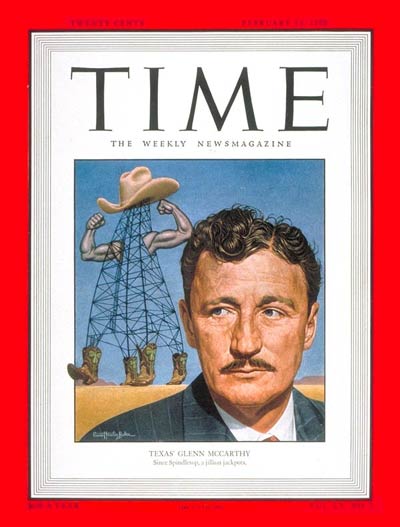Glenn McCarthy, Inc.
Just two years after being featured on the cover of TIME in 1950, Texas wildcatter “Diamond” Glenn McCarthy was in serious financial trouble with one of his many oil ventures. On April 8, 1952, the Baytown (Texas) Sun reported, ”Glenn McCarthy stepped down today as chairman of the board of the firm which made him a multimillionaire – but couldn’t pay its bills.”
The McCarthy Oil & Gas Company mortgage debt was $34 million, including his beloved 18-story, 1,100-room Shamrock Hotel, which “introduced Houston as a dynamic city of the future to the rest of the nation,” the Houston Business Journal later proclaimed. McCarthy Oil & Gas was lost to the Equitable Assurance Society of the United States, prompting McCarthy’s ouster.

Texas independent producer Glenn McCarthy appeared on the February 13, 1950, cover of TIME.
Undeterred, the Texas wildcatter who had discovered 11 oilfields by 1945 announced formation of a new company, Glenn McCarthy, Inc. He would seek new oil and natural gas fields in Bolivia. His plan was that the new firm would be a “poor man’s” company with 60 million shares to be sold at $2 each, encouraging “little investors” to gamble on his wildcatting reputation.
In October 1953, McCarthy offered the first 10 million shares of Glenn McCarthy, Inc. to the public. The company prospectus noted it was a speculative venture, with its principle assets being petroleum leases in Bolivia totaling 970,000 acres in the Andes foothills.
McCarthy intended to market the oil and natural in Bolivia, Argentina, and Uruguay, but not in the distant United States. Newspapers reported McCarthy had launched, “a new effort to climb from ‘rags to riches,’ a route over which he’s passed several times in both directions.”
A blitz of sales promotions and mail-in stock order forms reached newspapers all over Texas. Then came good news from South America: In September 1954, Glenn McCarthy, Inc., completed its first Bolivian oil well. The discovery was on the Los Monos concession and produced 100 barrels of oil a day in addition to some natural gas. The well’s depth was reported to be between 9.000 feet and 12,000 feet – the deepest well in Bolivia.
However, the lack of pipeline and rail infrastructure prohibited effective marketing of the crude oil to refineries (a frequent problem for wells drilled in remote areas, see Million Barrel Museum). Lack of infrastructure proved disastrous for Glenn McCarthy, Inc.
As described in The Big Rich: The Rise and Fall of the Greatest Texas Oil Fortunes, by Bryan Burrough, “McCarthy dragged himself back from Bolivia in 1957, bruised, battered, and, if not exactly penniless, no longer a rich man; unable to build a pipeline to transport the natural gas he had discovered, he sold his Bolivian interests to a group of American companies for $1.5 million, much of which he used to repay debts.“
Although McCarthy recovered somewhat financially, the Glenn McCarthy, Inc., passed into history, joining the legend of “Diamond Glenn” and leaving its collectible stock certificates. McCarthy and his wife Faustine lived a quiet life in a modest two-story house near La Porte, Texas. The once famous Texas wildcatter died the day after Christmas, 1988.
_______________________
The stories of exploration and production companies joining petroleum booms (and avoiding busts) can be found updated in Is my Old Oil Stock worth Anything? The American Oil & Gas Historical Society preserves U.S. petroleum history. Please support this energy education website. For membership information, contact bawells@aoghs.org. © 2021 AOGHS. All rights reserved.


